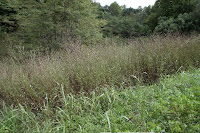 What could possibly be bad about the Pincushion Flower (Mourning Widow, Scabiosa atyropurpurea)? It is a beautiful flower and attracts butterflies like mad. Its seeds and information on propagation is readily available on many commercial Internet sites and it is easy to grow- in fact too easy.
What could possibly be bad about the Pincushion Flower (Mourning Widow, Scabiosa atyropurpurea)? It is a beautiful flower and attracts butterflies like mad. Its seeds and information on propagation is readily available on many commercial Internet sites and it is easy to grow- in fact too easy.California Invasive Plants Council reported a problem in 2005.
Scabiosa atropurpurea (pincushion flower or mourning bride) — Very common cultivar. Began to escape into wildlands 4-5 yrs ago and form near- monotypic stands in San Bruno grasslands. Spreading along trails and fire roads between Claremont Canyon and Strawberry Canyon in Berkeley."Since that time it has been listed as an invasive species in Texas and there are a lot of reports of its spreading to other areas. Linda Ellis reported her first discovery of it while traveling in Arkansas in the Spring 2009 Claytonia.
"We saw scores of butterflies and other pollinators feasting on plants that
were a total mystery to me. We began to photograph the thick stand of the spindly plant with the pale, multi-floret flowers. The Bugman put together a list of the butterfly species we found nectaring on the blooms and we estimated that about a third of the Arkansas and Missouri species normally found in the area were represented. So intense was their feeding that they ignored our presence as we photographed them."
Sounds like a great discovery so far. As they drove home, they started seeing dense stands of it covering the roadsides and choking out the native flora. Eventually it was identified as Scabiosa atropurpureai. There are now reports of its spreading to Kansas and other states.
Common teasel (Dipsacus fullonum) and cut-leaved teasel (Dipsacus laciniatus) are two other members of this family, officially listed as noxious weeds in Missouri, and are especially common on disturbed land and roadsides. Unfortunately, we are not alone with this problem. The Global Compendium of Weeds identifies it as a naturalized cultivation escapee and back in 1992 in Australia it was characterized as a "garden thug". Pincushion flower has now been identified in Greene, Stone and Barry counties.
What can you do? 1) Avoid planting Pincushion Flower and remove any that you have growing to reduce seed dispersal. 2) Consider planting butterfly gardens of native plants. (See Grownative.org). Common teasel (Dipsacus fullonum) and cut-leaved teasel (Dipsacus laciniatus) are two other members of this family, officially listed as noxious weeds in Missouri, and are especially common on disturbed land and roadsides. Unfortunately, we are not alone with this problem. The Global Compendium of Weeds identifies it as a naturalized cultivation escapee and back in 1992 in Australia it was characterized as a "garden thug". Pincushion flower has now been identified in Greene, Stone and Barry counties.
Resources:
Download a checklist of butterflies commonly found in Southwest Missouri from this Friends of the Garden site.
A comprehensive list of host plants can be downloaded at Friends of the Garden butterfly Host Plants.
A description of a butterfly garden is at this Missouri Extension site.
A web site with comprehensive information by individual species is at http://www.thebutterflysite.com/missour ... lies.shtml
The following description of the Pincushion Flower is from here.
Plants have a daisy-like head of small flowers (florets). Scabiosa atropurpurea (purple pincushion, mournful widow) is a much-branched annual or short-lived perennial growing to 1m. The leaves are in opposite pairs, the basal leaves lobed, upper leaves much dissected, with linear segments. The flower heads are 2-4cm across, with dark purple, red, pink or white florets, of which the outermost are the largest. Flowers in spring and early summer. The bristly fruiting head is oblong in outline.
